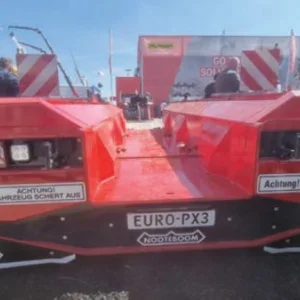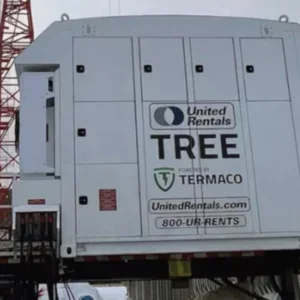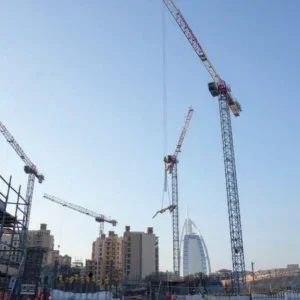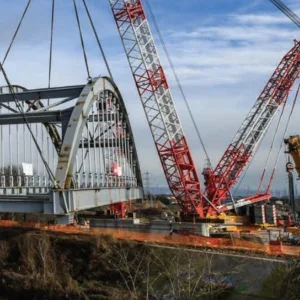For the world’s leading crane manufacturers, it is lifetime cost, not sale price, that should matter for crane owners. "We focus on the development of our routine aftersales service networks", says Eric Pommier, Vice President Crane Care EMEA at Manitowoc. "Our approach is to look at the cost of ownership to our customers, the lifecycle of the product, and develop a care and maintenance package to support them through that, and beyond. Our aftersales service provision is our differentiator."
Crane Care is Manitowoc’s crane service and support program. Launched in 2001, it is divided into five key disciplines: parts, service and technical support, technical publications, training and EnCORE, a branded rebuild, repair, remanufacture and exchange programme.
"2013 was an improvement over 2012 for our Crane Care side of the business," continues Pommier. "Cranes are getting older and people aren’t investing in new purchases as readily as pre-2008. It makes sense invest in ensuring cranes are kept working at optimum productivity for as long as possible. It prolongs their working life and increases their resale value significantly."
In a market where any downtime has a significant impact on profitability, a manufacturer’s reputation for uptime reliability can make all the difference in securing and maintaining sales.
"Despite the economic downturn, we have maintained the level of our workforce", adds Pommier.
"Investment in the training and support of our technicians, is critical as the labour market for skilled technicians is poor.
"We’re investing quite heavily in our aftersales network in Africa, which is an emerging market for us. It’s a huge continent, 10 000 km from north to south, and very fragmented so it’s crucial to have a good network of reliable service centres throughout the eight countries of the continent.
Closing the gap?
Early last year, Cranes Today examined the apparent gulf between promises and delivery on service. Opinion on whether this gap is closing is mixed, but it’s clear manufacturers are making service a priority in their business development strategy.
Prioritising customer service, and investment in service facilities, is by no means a new initiative for Liebherr. But the German company placed an even greater emphasis on service investment in 2013 with the opening of no less than four new service centres around the globe. The $20m centre in Miami, Florida, will further strengthen business relations with Central and South America and the Caribbean region, while Liebherr- Australia invested around $30m to coordinate service activities in Australia and New Zealand from a new centre near Sydney. The complex opened in March 2013 and accommodates a repair and service hall, including a spare parts warehouse, on an effective area of about 5,900 sq m, with adjacent office space of around 3,000 sq m.
The company ended its long running and successful partnership in Mexico with Nortrack de Mexico at the end of 2012 and replaced it with a new sales and service subsidiary, Liebherr Mexico. Under the umbrella of Liebherr-Werk Ehingen GmbH of Ehingen (Germany), the company will initially be responsible for the direct sale and service of Liebherr mobile cranes in Mexico and the other countries of Central America. The founding of Liebherr Mexico underlines the growing importance of this market for Liebherr. Mexico’s large-scale investments in the energy sector and in infrastructure in recent years has given rise to increased demand, especially for mobile and crawler cranes. The upshot of this is that not only are local crane rental companies expanding, but Liebherr customers from Europe are also setting up subsidiaries in Mexico and importing machinery into the country. The new company creates the basis for providing even better support for Liebherr customers in Mexico and Central America and for making customer services, including spare parts supplies, even more efficient in the region. Long term plans for Liebherr Mexico include developing duty cycle crawler cranes and deep foundation machines product areas, plus the subsidiary will also act as a platform for the activities of the other Liebherr construction machinery divisions.
Not forgetting their customers in Europe, in June 2013 Liebherr and Nagel opened a joint sales, rental and service centre for tower cranes and earthmoving machines in Frankfurt am Main. This new facility allows Liebherr to build on its current service to the local market and to provide an improved range of services for customers in the Frankfurt region. At the new site, Liebherr-Baumaschinen Vertriebs- und Service GmbH provides sales and service for earthmoving machines, Liebherr-Mietpartner GmbH offers earthmoving machines for hire and the Nagel group of companies offers a comprehensive sales portfolio. The total floor space used by the two companies is 5050 sq m,
It’s all about the ROI Terex Services, the service arm of Terex Corporation’s North American division, was formed following a merger between Terex Utilities and Crane America Services early last year and began trading under the name Terex Services in July. The combined company gives Terex customers access to support from an expanded area of coverage. "Our service teams focus a lot on preventative maintenance for our tower cranes", says Rick Smith, Vice President, Operations at Terex Services North America. "We’ve invested in the development of the Smart Inspector maintenance management system which allows us to inspect, track and consult with our customers as it relates to their specific needs. "
A maintenance management system holds information about a company’s maintenance operations. This data aims to help maintenance and service technicians work more effectively, for example, by determining which machines require maintenance and which storerooms contain the spare parts required. The information can also be used to help management make informed decisions, such as calculating the cost of machine breakdown repair versus preventive maintenance for each machine.
Smith continues, "we use the tool to establish a baseline reference for both the reliability and statutory compliance of each crane and component. The output is then provided to the customer as a plan document. We use the data to meet with the customer and develop both a short term and long term strategy. The output is delivered both in electronic format and in a bound book. It becomes a mutual roadmap for success and communication."
"Plus, it saves our customers money too", adds Brent Russell, Vice President Sales and Marketing, Terex Corporation. "By having a good picture of when parts are likely to need repair, or when machines will need servicing, we can pre-empt any problems and get more uptime. Most of our customers are now outsourcing our service needs, so they’ll turn to the OEM for support and repair when needed so they can be assured of a reliable and quality service.
"We distribute our mobile cranes through our dealer network and we’re also working closely with them to improve technology to support their customer service strategy."
Having access to such comprehensive information is invaluable to both OEMs and crane owners alike, particularly when decisions have to be made regarding the future of an aging machine or one in need of repair.
"When it comes down to it, it’s all about the ROI", explains Smith. "How much more can you get out of this crane. Should it be repaired, can its life be extended. We do the math and show a breakdown of costs and whether it’s cost effective to repair, refurbish or even rebuild. It’s brings us back to the total cost of ownership over the crane’s lifetime."
Repair, replace, rebuild
If there’s one sector where demand appears to be steady in all market conditions, it’s the remanufacture or rebuild of existing equipment. In boom times, companies look to extend the life of their crane because lead times for new cranes are so long. In a downturn market, refurbishing or extending the life of an existing crane can be a cheaper alternative to buying a new machine.
US heavy equipment repair and restoration firm Wheco has been carrying out Service Life Extension Projects, or SLEP, for over 30 years. President, Dave Wood explains, "we cut our teeth on providing SLEP programmes for the Air Force, Navy and Marine branches of the military. The term SLEP, which was created by the military, is the acronym for describing the ability to add additional safe and cost effective service life to aging and damaged cranes and equipment.
"When something will cost $2m to replace, it makes good business sense to invest half of that and get another 10 or 15 years of service out of it. Whether to replace or repair is a math equation – the cost of replacement versus the cost of repair or restoration."
While the decision on SLEP or restoration projects may simply come down to numbers, there are still several factors to consider when determining if there’s life left in an aging crane, as Wood continues, "there has been a lot of industry consolidation over the last 20 years. Names like Lima and Northwest have virtually disappeared leaving them with little to no market value and may not be worth the investment to restore. On the other hand crawler crane manufacturers like Manitowoc, Link-Belt, Terex/Demag/American, Liebherr and Kobelco are recognised brand names whose products hold value and are great candidates for service life extension projects. It is still a good idea to take a look at the particular model you are looking to restore and consider the popularity of that crane. If it is, or was a popular model like the Manitowoc 4100 or 888 it makes for an easier decision. On the other hand if it was a less popular model or size then you may want to reconsider a decision to restore. The value can be diminished by the availability of the manufacturer or market to support the product. Or, it simply may not be a very marketable crane if someday you need to dispose of it."
Further, advances in technology and the manufacture of cranes can mean that there’s just no other option than to restore if it’s not possible to replace like for like. "We recently took on a project to extend the life of a P&H 6250 that had been built in the 1980s, continues Wood. "This crane met all the client’s needs and they didn’t want to replace it with a new one. It took one person to operate it and was suited perfectly to its application. The current day replacement for that crane required five people to move it as well as the use of a service truck. We went completely through it and made it like new. Everything on the crane was touched down to the last nut and bolt and the client will be able to carry on using it for 10 years or more."
EnCORE is Manitowoc’s rebuild, repair, re-manufacture and exchange program. This partner programme provides appointed Manitowoc crane dealers the tools and training to offer repair and remanufacturing services under the EnCore brand. It began in 2011 in the US, and has expanded into Europe, Latin America, and more recently, in South Africa with the addition of Crane Load Tech (CLT) as an EnCORE partner. EnCORE partners provide customers with a local option for certified repair and refurbishment services under the leadership, and brand, of Manitowoc.
"To become an EnCORE partner requires a high level of training, certification and skills", says Pommier. "In order to qualify for the EnCORE program, dealers had to invest considerable time in training technical staff, as well as adding a trained structural engineer to its staff. The programme means we can be flexible by making repair and restoration services more easily available through our distributors, while still ensuring the highest quality.
"Adding Crane Load Tech as a partner is part of our commitment to developing our service network in Africa and bringing us closer to our dealers", he continues. "CLT became our second EnCORE partner in the EMEA region, although we now have five with a few more in the process of being certified.
All CLT’s work under the EnCORE program would be carried out at the firm’s workshop near Johannesburg. The workshop can accommodate at least eight cranes under roof at any one time and includes a boom repair bay. CLT offers comprehensive crane sales, certified repair and refurbishment services to customers in South Africa, Swaziland, Lesotho, Botswana, Namibia, Zimbabwe, Zambia, Madagascar, Mozambique and Malawi, for the complete range of Grove mobile cranes and Manitowoc crawler cranes.
An eye to the future
Recent proposals put forward by the Mayor of New York City’s office could have a startling effect on the future of the service and maintenance sector, not to mention the crane industry as a whole. The proposed legislation calls for a 25-year age limit on cranes in operation, a bill that would prohibit mobile and tower cranes manufactured more than 25 years ago from operating in New York City.
Cranes would be removed from service based on the original date of manufacture or based on the age of the crane’s oldest component, whichever is greater. In addition, according to the statement, all cranes would require "load cycle counters to record data regarding every lift that a crane performs – which is critical to setting maintenance schedules and overall operability over a crane’s service life."
Needless to say there has been a strong, and mixed, reaction from the industry. While some welcome the move which they believe will improve the safety of crane operations at construction sites, others state that there is no evidence that cranes have ever failed because of age or fatigue, and dismiss the proposal out of hand.
This is not the first occasion when the age of cranes has come into question. A petition proposing restrictions on the use of hammerhead and luffing tower cranes older than 20 years was brought to the Californian Occupational Safety and Health Standards Board in 2007. The petition was denied, with the Board reporting that existing testing, inspecting and certification requirements have been effective in assuring crane safety and the requirement for age based restrictions on cranes had not been proven. In short, the Board concluded that regulation and effective maintenance by qualified and skilled technicians had more bearing on crane safety than age.
While the situation in New York City is yet to be concluded, the industry will be keeping a close eye on how it plays out.






